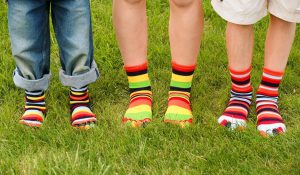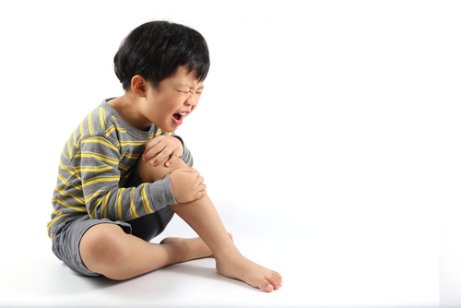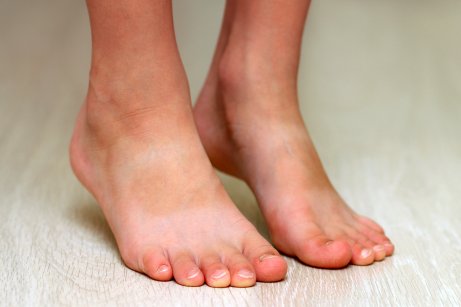5 Orthopedic Problems that Are Common in Children

Today we’ll go into detail about the 5 most common orthopedic problems that can affect children. Orthopedic disorders are related to deformations that can occur in the human body.
These may appear during childhood, and treatment is possible through the use of specific techniques and equipment.
There are certain parameters that estimate expected growth during childhood. However, it’s also true that children don’t always develop according to these standards.
Certain circumstances may arise that, while they aren’t a serious threat to children’s health, still require special care.
In this category we can include some minor breathing issues, problems with vision or hearing, allergies, and so on. We can also include orthopedic problems on this same list. These sorts of issues are quite common among children.
5 orthopedic problems that are common in children
Below, we’ll talk about 5 different types of malformations that may occur in children. These may or may not be congenital.
We’ll also offer you a brief overview of common treatments for each particular problem.
1. Flat feet
When we’re born, we all have flat feet. However, as time goes by, the inner sides of the soles of our feet develop an arch. This is a normal part of development.
One of the most common orthopedic problems among children is, precisely, the lack of development of this arch. The first symptom that appears is a weakness in the ankles, which go inwards when the child walks.
This condition can sometimes be painful for children. If so, a specialist may recommend the use of orthopedic insoles or some other sort of shoe support.
It’s important to remember that having flat feet doesn’t imply a serious health problem. In fact, children with flat feet can carry out any type of activity, including sports.

2. Bow legs
Genu varum, more commonly known as bow-leggedness, is another common deformity in children.
Children who suffer from bow-leggedness have a deviation in their legs at the height of their knees. This deviation causes their legs to separate and to arch outwards.
This condition can be hereditary and is frequent among babies. Just the same, the problem often goes away on its own with time.
As long as there is no serious disease, such as rickets or Blount’s disease, this condition doesn’t usually require treatment. Pain in the shinbone or the knee joint may be a sign of these conditions.
3. Knock-knees
More formerly known as Genu valgum, this problem is just the opposite of the above disorder. In this case, a child’s knees come together in the middle, and their muscles and legs are deviated.
Unlike genu varo, this condition tends to appear between the ages of 3 and 6. During this period, a person’s legs go through changes that affect their alignment.
In both cases, the main issue that needs to be considered isn’t aesthetics, but rather function. As long as the curvature doesn’t cause pain or affect a child’s activities, then usually no treatment is necessary.
“When we’re born, we all have flat feet. However, as time goes by, the inner sides of the soles of our feet develop an arch. This is a normal part of development”
4. Clubfoot
This disorder refers to a malformation that is just the opposite of flat feet. Children who suffer from clubfoot have an arch that is too high. This usually doesn’t produce major complications, except that certain shoes may be uncomfortable to wear.
Just as in the problems mentioned above, the presence of pain is reason enough to consult with a doctor. The same is true if the disorder affects a child’s daily life or the deformation is extremely prominent.
5. Tiptoes
When children first learn to walk, they almost all walk on tiptoes. However, this behavior should go away by the time they reach three years of age.
If this doesn’t occur, the causes could be muscle weakness or more complex issues, such as those having to do with the brain or the nervous system.
It’s important to see a doctor early on in order to rule out these complications and correct the problem.
How to identify orthopedic problems in children?
Observation is the first tool that parents can use to detect if their child suffers some problem having to do with body structure.
Professionals affirm that it’s normal for children to appear bow-legged during their first 18 months of life. In other words, children often have unconventional curvatures in their legs at a young age.

It’s important to take into consideration the fact that this is the age when children are just learning how to walk. This requires a great deal of strength from the lower body, which is still developing.
Closer to the age of two, most children will have straighter knees. Another year later, their knees may come together. From then on into childhood, their characteristics will need to adjust progressively to “normal” standards.
If parents observe any abnormality in this final stage, they can discuss their concerns with their pediatrician and request evaluation. Of course, this is especially true if their child experiences pain.
Physical examinations as well as studies such as X-rays will be key in proper diagnosis.
Today we’ll go into detail about the 5 most common orthopedic problems that can affect children. Orthopedic disorders are related to deformations that can occur in the human body.
These may appear during childhood, and treatment is possible through the use of specific techniques and equipment.
There are certain parameters that estimate expected growth during childhood. However, it’s also true that children don’t always develop according to these standards.
Certain circumstances may arise that, while they aren’t a serious threat to children’s health, still require special care.
In this category we can include some minor breathing issues, problems with vision or hearing, allergies, and so on. We can also include orthopedic problems on this same list. These sorts of issues are quite common among children.
5 orthopedic problems that are common in children
Below, we’ll talk about 5 different types of malformations that may occur in children. These may or may not be congenital.
We’ll also offer you a brief overview of common treatments for each particular problem.
1. Flat feet
When we’re born, we all have flat feet. However, as time goes by, the inner sides of the soles of our feet develop an arch. This is a normal part of development.
One of the most common orthopedic problems among children is, precisely, the lack of development of this arch. The first symptom that appears is a weakness in the ankles, which go inwards when the child walks.
This condition can sometimes be painful for children. If so, a specialist may recommend the use of orthopedic insoles or some other sort of shoe support.
It’s important to remember that having flat feet doesn’t imply a serious health problem. In fact, children with flat feet can carry out any type of activity, including sports.

2. Bow legs
Genu varum, more commonly known as bow-leggedness, is another common deformity in children.
Children who suffer from bow-leggedness have a deviation in their legs at the height of their knees. This deviation causes their legs to separate and to arch outwards.
This condition can be hereditary and is frequent among babies. Just the same, the problem often goes away on its own with time.
As long as there is no serious disease, such as rickets or Blount’s disease, this condition doesn’t usually require treatment. Pain in the shinbone or the knee joint may be a sign of these conditions.
3. Knock-knees
More formerly known as Genu valgum, this problem is just the opposite of the above disorder. In this case, a child’s knees come together in the middle, and their muscles and legs are deviated.
Unlike genu varo, this condition tends to appear between the ages of 3 and 6. During this period, a person’s legs go through changes that affect their alignment.
In both cases, the main issue that needs to be considered isn’t aesthetics, but rather function. As long as the curvature doesn’t cause pain or affect a child’s activities, then usually no treatment is necessary.
“When we’re born, we all have flat feet. However, as time goes by, the inner sides of the soles of our feet develop an arch. This is a normal part of development”
4. Clubfoot
This disorder refers to a malformation that is just the opposite of flat feet. Children who suffer from clubfoot have an arch that is too high. This usually doesn’t produce major complications, except that certain shoes may be uncomfortable to wear.
Just as in the problems mentioned above, the presence of pain is reason enough to consult with a doctor. The same is true if the disorder affects a child’s daily life or the deformation is extremely prominent.
5. Tiptoes
When children first learn to walk, they almost all walk on tiptoes. However, this behavior should go away by the time they reach three years of age.
If this doesn’t occur, the causes could be muscle weakness or more complex issues, such as those having to do with the brain or the nervous system.
It’s important to see a doctor early on in order to rule out these complications and correct the problem.
How to identify orthopedic problems in children?
Observation is the first tool that parents can use to detect if their child suffers some problem having to do with body structure.
Professionals affirm that it’s normal for children to appear bow-legged during their first 18 months of life. In other words, children often have unconventional curvatures in their legs at a young age.

It’s important to take into consideration the fact that this is the age when children are just learning how to walk. This requires a great deal of strength from the lower body, which is still developing.
Closer to the age of two, most children will have straighter knees. Another year later, their knees may come together. From then on into childhood, their characteristics will need to adjust progressively to “normal” standards.
If parents observe any abnormality in this final stage, they can discuss their concerns with their pediatrician and request evaluation. Of course, this is especially true if their child experiences pain.
Physical examinations as well as studies such as X-rays will be key in proper diagnosis.
This text is provided for informational purposes only and does not replace consultation with a professional. If in doubt, consult your specialist.








